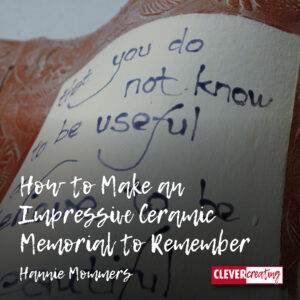
The biggest advantage of clay is that it is a flexible material as long as it is not fired. The downside is that the lifespan is short in some cases.
Sometimes such a short lifespan is the intention. In this article, I want to show the power of making a ceramic memorial, which was not supposed to last long.
An artist’s clear reasoning for allowing their work to be temporary can add an extra level of significance to their work.
Some of the links are affiliate links. As an affiliate associate, I earn a small commission when you purchase any of the products offered through the shared links at no extra cost to you. This helps me to maintain this website and I thank you for supporting me.
Table of Contents
Making a ceramic memorial
Clay offers many possibilities to make a memorial. Varying from urns to objects. Depending on the shape (no rainwater should remain in it), ceramics are durable enough to be used outside.
What is a memorial?

A memorial is meant to remember an event or a person. Usually, a memorial is an object, but it can also be a poem or book, an event such as a concert or meeting, or a dedicated area, such as a memorial garden.
Ceramicists will make urns or objects, both on commission and for themselves. My father-in-law’s ashes are contained in a beautiful porcelain urn made by Yeung Yuk Kan. When my father died, I made a book of clay for him with stamped and written texts in it.
Because there are so many possibilities to decorate, ceramics is a fantastic discipline in which to make a memorial. Hand painting, screen printing, and stamping offer many possibilities to create something very personal.
The Morecambe memorial uses screen printing in a tasteful, yet simple way.
A group of 23 Chinese labourers died

On 5 February 2004, a group of 38 cockle pickers was surprised by the upcoming tide. Only 15 of them survived this disaster. They were illegal Chinese workers, most of whom were previously employed as farmers. Only two of them had been fishermen.
The group had been signalled by British cocklers who tried to warn them. But the Chinese didn’t speak English and didn’t understand the tapping on the watches.
There had been an emergency call by mobile phone to the authorities, but probably due to the language problem, the scale of the disaster was unclear at that time. Only one person was rescued by helicopter. Fourteen made it back to the coast on their own.
They were illegal immigrants. Badly treated, underpaid, and not warned of the danger of the tides of the sea.
Reflections of artists on big events
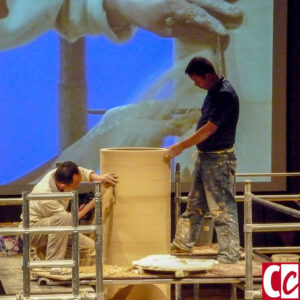
This text could have been part of a newspaper article. Something like this most probably was written in the newspapers in the days following the fishing disaster.
If I would have read it back then, I would feel sorry for the 23 people, sigh, and read on. Because that is what we usually do when reading the newspaper, don’t we?
But in 2009 I was at the Aberystwyth International Potters Festival. And there I saw a movie that made a huge impact on me. This film is made by Alex McErlain, Stephen Yates and John Davis and shows the installation that Victoria Eden has made as a memory to the 23 Chinese cockle pickers who died.
In my eyes, this is a major function of art: reflecting on big events. It’s a tradition that goes from the victory columns of ancient Rome to the Veterans Memorial in Washington. Sometimes made as an assignment from the authorities, sometimes made as an impulse the artist had.

The only limit to your impact is your imagination and commitment.
~Tony Robbins
February 5th 2004 – Ceramics Installation
Victoria Eden’s installation is a meticulous piece of work. I can’t remember anymore how long the movie was, I just remember I was looking in awe at the incredible amount of work Eden has put into it.
In the movie, it’s not clear whether Victoria Eden had any help, yet, looking at her actions, I could fully understand the effort it took her to make the imprints in plaster out of the sand and the stepping stones!
The plaster casts of the beach were moulds for the ceramics stepping-stones she made. Each form has the name of one of the deceased on it in English as well as Chinese, and a quote about migration, loss and modern slavery.
The 23 stones were laid on the beach after finishing. The tide could wash over them and eventually, all the stones would vanish.
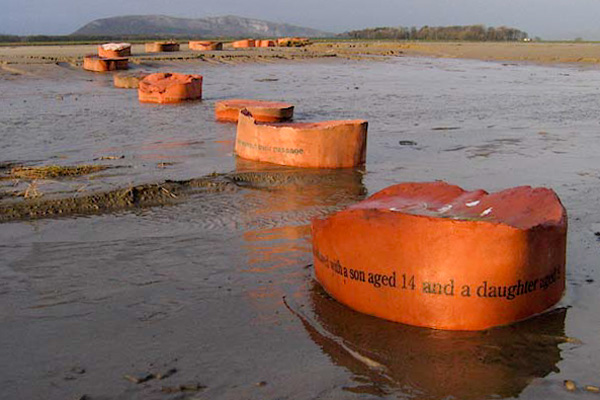
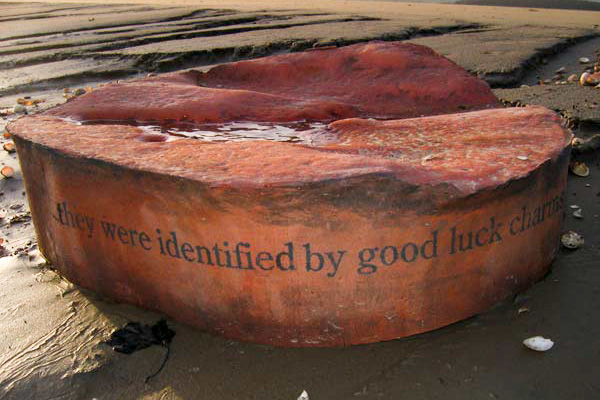
Photo credits: Victoria Eden ©
Why do we appreciate art?

Partly Victoria’s memorial appealed to me because I sympathized with those underpaid, invisible, hard-working people that only tried to make a living.
Partly the monument of Victoria Eden appealed to me because I had done a beach project when I was a student at the Art’s Academy in Tilburg, the Netherlands. We made an imprint of the sand in plaster and because it was so big, we had a lot of difficulties getting the huge thing out of the sand and in an upright position.
The amount of work that someone puts into a work of art, of course, says nothing about the appreciation that an outsider can muster for it.
I can still remember that I had made an aquarelle of a friend. An aunt of hers asked me how long it had taken me and I honestly said: half an hour. Gone was the appreciation! (This was in 1978, you can see what an impact the comment had).

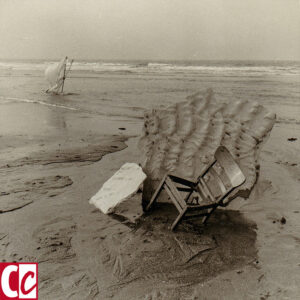
Develop your taste
Yet the main reason we appreciate art is whether it immediately appeals to us or not. This has to do with colour, texture, shape, and material.
We can develop a taste for art by training ourselves in looking. A friend called it: “To look is to taste with your eyes”. Visiting a museum, making something ourselves, and exchanging ideas with friends are excellent tools for this.
Related: 15 Top Tips to enjoy Art for Free
I like the whole idea behind this monument of Victoria Eden. The idea of temporary life and stepping-stones to the left-behind Chinese families. What do you think? Tell me in the comment box below.
This article is an update. Originally published on 8-09-2013.



What a beautiful memorial Victoria created for these 23 drowned men…
They were seen, honored, and respected in death as they were never during their lifetime.
It saddens me how badly some people are still treated. When will we ever learn?!?
Modern slavery is a much uncovered and denied area unfortunately, Kadanza. And these men and women, even though they weren’t employed by someone as far as I know, were a kind of modern slaves – underpayed and indeed much disregarded.
And these men and women, even though they weren’t employed by someone as far as I know, were a kind of modern slaves – underpayed and indeed much disregarded.
Your question saddens me because my instant reply is: never, which doesn’t give much hope for the future, does it?
Two months later, I read your answer…
The future looks quite bleak indeed if you realize what’s going on.
Not related to this ceramic memorial, but to the ‘when will we ever learn’ question: I am listening to a podcast series about femicide right now, also an uncovered and denied subject, which makes me both angry and incredibly sad and deflated. I have to balance these kinds of subjects with lighter and more hopeful ones, or my rage will devour me!
Pff, I know what you mean. At times, I want to give up too. Not worry any longer about the climate, plastic use, hesitant or extreme right-wing politicians, sexism, and racism. The list seems endless.
At times, I want to give up too. Not worry any longer about the climate, plastic use, hesitant or extreme right-wing politicians, sexism, and racism. The list seems endless.
Fortunately, my son pulls me back up at times like this: Come on, mom, you certainly inspire me and that’s how change begins. Luckily for you, you too have a bonus child that gives you much joy to keep your spirits up.
Hearing about those poor people from China that died like that saddened me. I don’t understand why they couldn’t just find someone who could translate and warn them? The people taking advantage of any person like this should be ashamed of themselves. Sorry for the rant.
I don’t know how to work with ceramics but I’m tempted to start learning. Art seems to me like taking a piece of yourself and leaving it in your painting, ceramic bowl or poem. Every time I read something I know I’m holding a part of someone’s soul in my hands. It’s a very special experience for me.
What Victoria did is truly amazing!
I understand your rant completely, Julie, I feel the same about the whole affair. This was years ago and nothing much has changed so far. There is still slavery all over the world, we don’t call it that way anymore but it is the same.
So beautifully said “a part of someone’s soul”. I am happy you feel it that way because then the artist has done a great job. And if you are tempted to start making something yourself, please don’t hesitate, do! You don’t have to buy a lot of equipment to start. For instance, you can start by making paper maché, for which you only need old newspapers and wallpaper glue.
Thanks for your comment, Julie, and I hope you start creating!
Very interesting article and good example of the ceramic memorial to commemorate the fishing disaster in Morecambe Bay. This is a touching tribute and very tastefully and respectfully crafted. I like the way that each piece has its own meaning and significance.
How long would it take an average person to learn how to craft a ceramic memorial of their own? Is this something that could be possible or do you recommend purchasing from an artist?
Yes, it’s beautiful, isn’t it, Aly. I love it as well very much.
A memorial as complicated as Victoria’s would take years to learn. Nevertheless, I would always prefer you to try and make it yourself over buying from an artist. Even if I was that artist!
The reason is first that it is really fulfilling to make something yourself. And second that you would be the one having the biggest emotional involvement. Of course, an artist is very capable to empathize with an assignment, making it a good second choice if you neither have the time nor the possibilities to invest in a time-consuming activity.
Thanks for this interesting question!